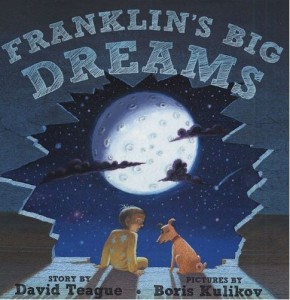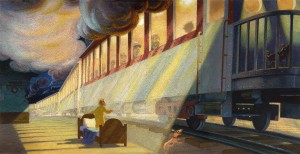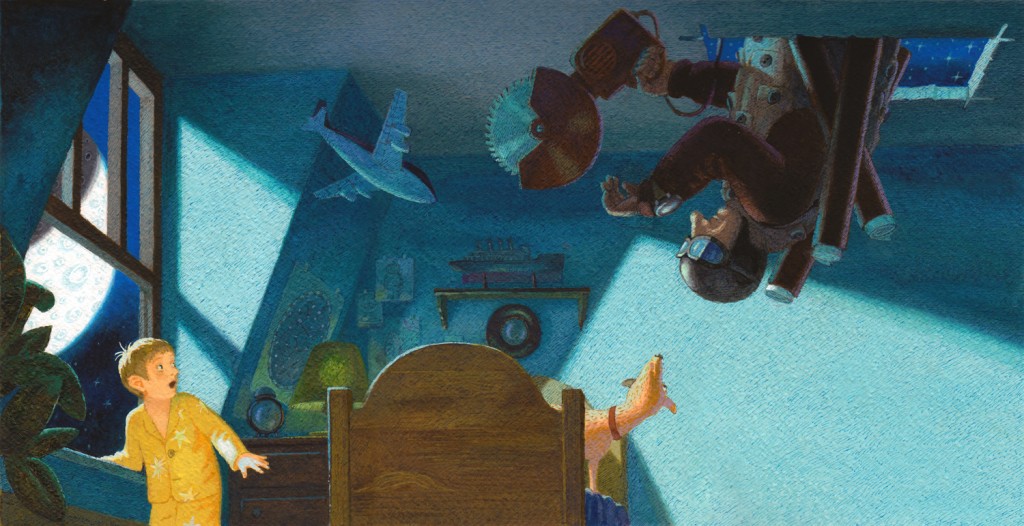By Nicki Richesin, The Children’s Book Review
Published: September 20, 2011

David Teague lives in Wilmington, Delaware, with his wife, the novelist Marisa de los Santos, and their two children, Charles and Annabel. David teaches literature at the University of Delaware. “Franklin’s Big Dreams,” is his first picture book, based on dreams he had when he was little but didn’t quite figure out until he wrote “Franklin.” Next up for David is “Billy Hightower,” a picture book about a boy who lives on top of the highest building in the world, so high that when it rains on everybody else it doesn’t rain on him.
Nicki Richesin: What first drew you to writing books for children?
David Teague: I used to write books for adults. Probably ten of them, all unpublished, and rightfully so. Big, weighty, serious, books about what I thought were big, weighty, serious subjects, like good versus evil and the meaning of life, man’s inhumanity toward man, and all that. And boy were they boring. But when I began to tell stories to my children, back when they were younger, I noticed that my storytelling was a LOT more fun—for me and for my audience. So I learned to let my imagination loose, to think more like a child, and my stories turned out much better after that.
 In your book, FRANKLIN’S BIG DREAMS, every night a construction crew bursts through Franklin’s bedroom wall and builds train tracks, a canal and a runway. Did you have a similar experience as a child, a recurring dream that you could direct the way you wanted?
In your book, FRANKLIN’S BIG DREAMS, every night a construction crew bursts through Franklin’s bedroom wall and builds train tracks, a canal and a runway. Did you have a similar experience as a child, a recurring dream that you could direct the way you wanted?
When I was little, I DID dream about railroad tracks running past my bed (I still do sometimes–also about highways and runways and ship channels).
I think maybe the dreams started because, when I was little, as I was trying to fall asleep, which I often had trouble doing, I could hear trains rumbling out of a tunnel in the distance, and hear them blowing their horns as they passed through the town not far from where I lived. It was a nice feeling to lie in bed and think about people out there moving through the night, all going to their separate places.
And I think what I had in my mind as I was falling asleep managed to sneak into my dreams.

So a railroad got into my dreams, and in my dreams, after the trains thundered past, I always noticed the tracks curving around from behind my headboard and leading beside my bed and thence out again through the back wall of my bedroom. They were seriously not more than 2 feet from me.
After that, they led across the backyard, and after that into the great beyond. I was never sure why the tracks were there, or where they eventually took people. Sometimes in my dreams, after the train full of lucky passengers had thundered past in their brightly lit cars, I’d get out of bed and follow the rails on foot to see where they went, but since I was walking, I never got very far. When the woods behind my house got too dark, I always turned around and went back to my bedroom (in the dream—I never really left my bed of course).
Next, I usually woke up from the dream and checked beside my bed for railroad tracks and felt a little sad to find none.
So I always wondered where those tracks led. That’s where Franklin comes in, I guess. Even though I couldn’t solve the mystery, I thought if I made up someone a little bit smarter than I am, he could do it for me. Seriously. So I just imagined what would happen if a guy like Franklin were actually awake when the builder of those tracks showed up in his bedroom, because I thought he’d be able ask a few questions and figure things out. Which he did.

What advice would you give to an aspiring writer?
I would advise: write about something you love, because if you’re like me, you could be working on it a LONG time. Years. Ten years. Twenty. Write about something close to your heart, tell a story you believe in, because sometimes, even if it’s hard to sit down to work, even if there are days you don’t believe in yourself, you always have to believe in your story. And if you do, you’ll pick up your pen and write, which makes you a writer.
I know you have a musical and balletic (graceful) family and you play the violin. Have your musical talents influenced your writing at all?
I love music—Vivaldi, Bartok, Thelonious Monk and Lynyrd Skynyrd come to mind. Our whole family does love to dance, sing, and play instruments, although I have to bow out when the singing starts. I love poetry and the music of language, too. As a matter of fact, this subject came up last week as I was revising my newest picture book, “Billy Hightower,” with my editor Kevin Lewis. We wanted to get as much information across with as few words as possible, which is often the goal in a picture book, and as a matter of fact, we ended up working very hard on the rhythms of the story—both in individual lines and in the events of the story itself—to communicate meaning, tone, and emphasis without actually adding words. The wonderful poem “anyone lived in a pretty how town,” by e.e. cummings came up because it has at least two rhythmic cycles that contribute structure and sense to the story he’s telling. One involves the seasons, and the other, my favorite and most haunting, is a litany of celestial bodies and weather: “sun, moon, stars, rain.”
In your breathtakingly tender essay, “Miles to Go Before You Sleep” in WHAT I WOULD TELL HER, you write about your sleep-deprived walks in Philadelphia with your infant daughter Annabel. Did Annabel’s continued insomnia lead you to writing about Franklin’s nocturnal adventures?
Yes—there is a magic to things that happen at night—and though some of what occurs in that essay is the opposite of magic, the feeling Annabel and I often shared–what suffuses Franklin–is the lift your spirit feels at the wonderful dark colors, bright lights, enigmatic sounds, and mysterious activities of nighttime. Even in Boris’s illustrations (especially in Boris’s illustrations).
I think this shared experience of the night made its way into Franklin’s story.
As a professor of literature at the University of Delaware, who are your heroes in children’s literature?
William Steig. That guy can dive into a plot and take off running full speed and bring you right along with him, especially if you happen to be five. And his plots run like express trains, and break your heart. “Amos and Boris,” for example.
Crockett Johnson. “Harold and the Purple Crayon” is the Hope Diamond of stories. One of the most perfect plots I’ve ever read. It’s a classic of American literature, if you ask me, right up there with “The Great Gatsby,” and “Invisible Man,” only with a happy ending.
Kevin Henkes. I feel four to six years old every time I pick up one of his books. In the best possible way. If his story happens to be about a girl, as in “Lily’s Purple Plastic Purse,” then I feel like a four-to-six-year-old girl. In the best possible way.
Going older—Madeleine L’Engle, Susan Cooper, J.K. Rowling. They shaped (and are shaping) generations.
What are you reading with your children Annabel and Charles these days?
Annabel and I are actually reading “Over Sea, Under Stone,” by Susan Cooper. She’s nine, and it’s a good read-to book. Charles and I just finished “M.C. Higgins the Great,” by Virginia Hamilton, together. He’s twelve, and we read separately and discussed. I loved that book when I was twelve and was very gratified that he loved it too.
Could you tell us about any upcoming books you have in the works?
The manuscript of “Billy Hightower,” just went to Antoinette Portis for illustrations. Billy lives on top of the tallest skyscraper in the world, so high that when it rains on other people, it doesn’t rain on him. One day, a bunch of guys in hardhats build another building as high as his, and a girl wearing a hat comes to live on it. Billy tries to tell her his name, but the wind snatches his words away—he tries to fly a note over, but the wind snatches that, too, and the same thing happens when he tries to dangle a kite with a message on it. So—his challenge is to reach this new girl—
Antoinette, whose art is very simple, elegant, and powerful, has done some sketches, a couple of which literally brought tears to my eyes—so I can’t wait to see the whole book. Sometime early in 2013 . . .
Nicki Richesin is the editor of four anthologies,What I Would Tell Her: 28 Devoted Dads on Bringing Up, Holding On To, and Letting Go of Their Daughters; Because I Love Her: 34 Women Writers Reflect on the Mother-Daughter Bond; Crush: 26 Real-Life Tales of First Love; and The May Queen: Women on Life, Work, and Pulling it all Together in your Thirties. Her anthologies have been excerpted and praised in The New York Times, the San Francisco Chronicle,The Boston Globe, Redbook, Parenting, Cosmopolitan, Bust, Daily Candy, and Babble.
